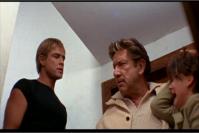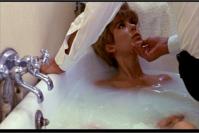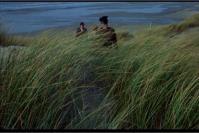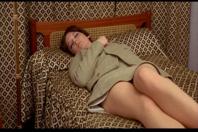|
Brando creates an impression,
no question. The Night Of The Following Day is the last film wherein he
appears as a slim, viable hipster before surrendering to the tragic obesity
that would eventually make him a freak. His character is really himself, a
mid-fifties beat replete with emotive jive talk and de rigueur sexual cool. No
scene shows this better than the dispute with Boone over their hostage. Brando
understands immediately that Boone is a sexual sadist, intends to rape the girl
somewhere along the line. They argue:
Brando: What's going on, man?
Boone: She tried to leave.
Brando: (raised) I was upstairs. I saw what
you did.
Boone: (snarls at the sobbing girl) Shaddup!
Brando: Listen,
man, if you wanna get freaky you don't do it with her --
(Boone laughs
harshly)
Or there's the fight with Moreno.
When she sees him leaving the girl's room, she makes a paranoid assumption
(fueled by coke), loses it, attacks Brando. Brando does no explaining (although
we know he's innocent), merely challenges her by smashing a bottle and handing
it to her, urging her to disfigure him if she really thinks he doesn't love
her. Because of the real-life tension between Brando and Moreno, the scripted
fight becomes a real fight. According to Peter Manso in his bio of Brando,
Brando was flying in various women to help him pass the time off the set and
still messing around with Rita. "Even though she lost the script, she stayed in
character." (as quoted in Brando, the Biography, Peter Manso, p. 645)
This ability to improvise within
context in order to give an edge to character and scene was something that both
Brando and Moreno were familiar with; Brando had studied the Stanislavski
"Method" under Stella Adler, Moreno under Jeff Corey. In those days everyone
wanted to see Brando lose it, go psycho, do his Stanley routine, knock a woman
around. The angry man was a period figure, a universal post-war male trauma.
Anger was the root sexual power of the modally hip, the release that precedes
the release.
In his now almost forgotten 1957
essay The White Negro, Norman Mailer says: "The unstated essence of Hip, its
psychopathic brilliance, quivers with the knowledge that new kinds of victories
increase one’s power for new kinds of perception.... In short, whether the
life is criminal or not, the decision is to encourage the psychopath in
oneself."
So to understand the Brando style,
we have understand what it meant to be hip. Dress him in black, with jack boots
and a chauffeur's uniform, he's undercover; dress him in black, tight T-shirt
and slacks, and he's hip, the existential bohemian with a machine gun and a
chick to protect. The chick of course is the hostage, Dupont's daughter. His
character is a moralist -- just as Brando was, albeit in the instinctual sense,
not institutional. Certainly, he's a criminal, but a nice one; here he's Left
Bank gone bad.
We never see the gang discussing
strategy -- events just happen. Boone flies from Le Touquet to Paris, enacts
the elaborate "clean money" scheme, instructing by phone, then shadowing,
Dupont (father of the kidnapped girl) as he exchanges the marked bills for
clean ones at two different banks, then flies to Le Touquet with the money.
Events happen -- familiar scenarios need no prompting. Brando unwraps a brick
of plastique, wires it, then has Vi drive him to the airport beacon which he
ascends like a man on a personal mission of revenge, not some local plan. But
this, of course, is this point: everyone has a personal agenda. When Brando
blows the tower, it's an expression, not a tactic. When Boone tortures and
rapes (off-camera) the girl in defiance of political logic, it's an expression,
not a tactic. When Vi and her brother die in flames... it's merely an
expression of their respective desires, where Fate is an accomplice, not a
Hunter. Thus the action is existential throughout.
|


|


